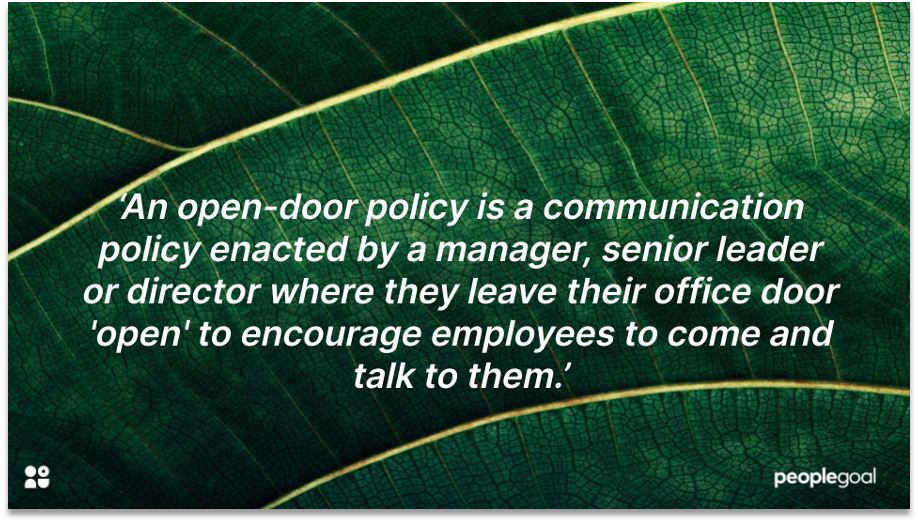Hierarchal organizational structures are top-down. Hierarchy cultures get a bad rep for being outdated and rigid. Some of this criticism is true, but there are many benefits to clear expectations and authoritative leadership.
Hierarchy cultures take oversight very seriously – (expect your boss to check in on that task you put on hold yesterday…). Every employee has a supervisor or manager that oversees their work. In theory, this keeps everyone in the organization accountable and efficient – especially for those of us who are less self-motivated than others.
Think about how this impacts on two key areas: 1) Authority and 2) Decision-making. Clearly, a top-down approach creates clear relationships between individuals in a company. It’s immediately possible to see who has the authority to act in a certain way, and who bears the most responsibility. Secondly, decision-making power is held in fewer hands than in alternative company structures.
If only managers and executives make decisions, blind spots can arise. Erin Meyer highlights that organizations in countries such as Japan, the Netherlands and Germany have consensual company cultures around company decision-making. The process takes longer, as there are more stakeholders involved. However, more perspectives are taken onboard. Solutions are fleshed out, and implementation times are thus quicker.
Leaders often prioritise rapid or ‘decisive’ decision-making over a democratic process. In a fast-paced world, we can under-value taking time to solve complex problems. For this reason, lower-level employees aren’t consulted. But with more eyes on the ball, collaborative cultures arrive at solutions that are often more sustainable and well thought out than those in hierarchal cultures.
With this in mind, we’ll explore some key pros and cons of hierarchy culture. Rather than throwing out hierarchies altogether, it’s important to think how they can be adapted to meet the future of work.
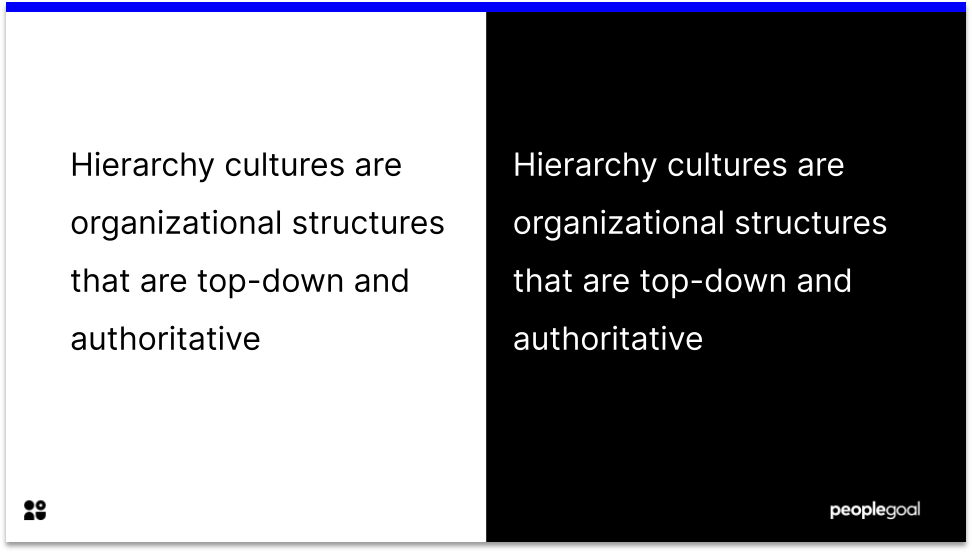
What are the four main types of organizational culture?
The four main company culture types are:
1. Clan
2. Adhocracy
3. Hierarchy
4. Market
You can see the differences when you look at organizational charts. A hierarchal organization structure is top down, with the CEO branching off downwards to the board of directs and finally the lower company levels.
A clan culture promotes flexibility in working practices, while an adhocracy culture emphasizes autonomy and risk-taking. Market cultures have demanding CEOs who advocate for a competitive environment, even among co-workers.
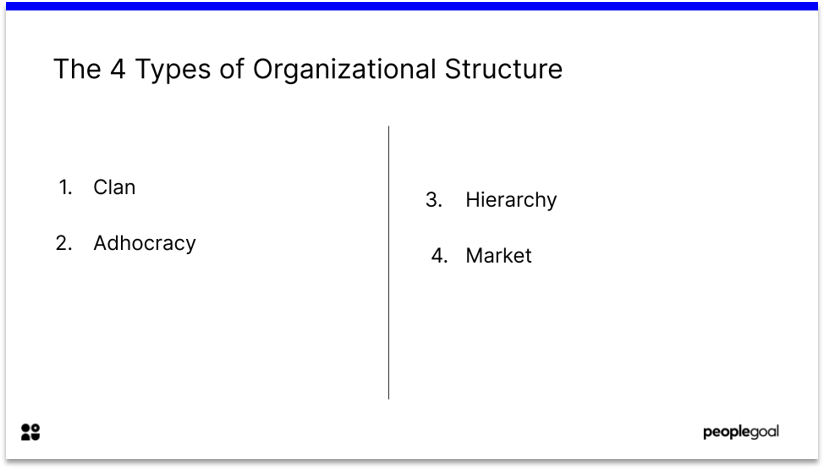
History of the Hierarchy Culture
Hierarchal cultures have been around since ancient times. Societies such as ancient Egypt based their society around a pharaoh. Power was cascaded in a pyramid structure. While things have changed a lot since the first pharaohs, hierarchal companies continue to use the same visual structure – with one person (the CEO) at the very top.
A top-down approach is perhaps what comes to mind when most people think about corporate cultures. In the 20th century, employees worked their way up the ladder of the company. The layout of offices was even designed to motivate this upwards climb – as employees moved from cramped cubicles up to spacious corner offices. As your career advanced, so too did your authority to speak on company matters.
In the 21st century, we’ve seen a move away from hierarchy-based companies towards more collaborative approaches. But in reality, hierarchies are still the most prominent organizational structures.
More accurately, organizations adapt this traditional structure to their customer and employee needs. Leaders seek out the perspectives of individuals at all levels of the organization. Innovations such as 360 feedback and open-door policies promote the idea that leaders are ‘part of the team’ as much as they are authority figures.
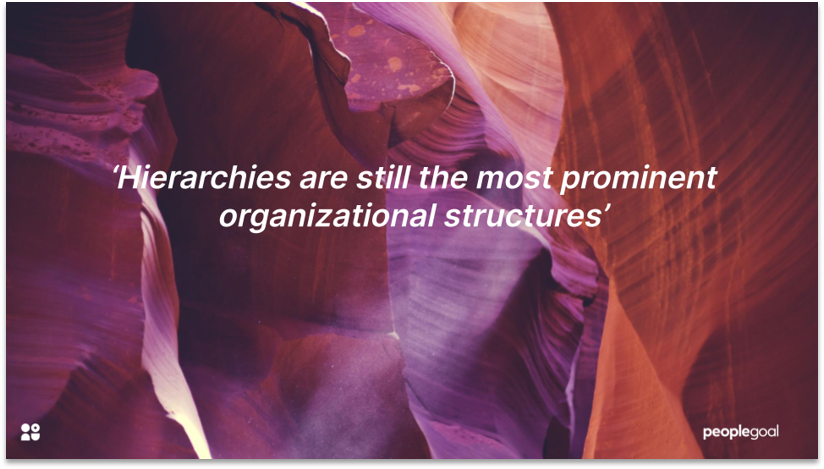
Pros of a Hierarchy Culture
Motivates you towards promotion
In a hierarchal structure, there’s only one way up. We know what we need to do to get to the next rung on the organizational ladder.
This gives us a sense of purpose. It motivates us to develop the skills we need to reach the next level.
Provides stability and routine
We don’t all want to be leaders every day. In hierarchal cultures, authority is clear and gives us direction. Hierarchies depend on stability and control. A supervisor sets tasks for their employees every day. Rather than being thrown in at the deep end, leaders establish clear expectations.
For example, some people find authoritative work environments comforting. You know what you’re signing up for: arrive at 9am, do the tasks set, go home when you’re done. Employees in hierarchal companies often feel secure, as they know what is expected of them.
Fosters camaraderie
There’s no ‘I’ in department team! In a hierarchy, it’s not just about top-down authority. Departments work collaboratively to achieve shared goals. Working closely together, teams build bonds that foster psychological safety.
Even if hierarchy cultures create a little more distance between supervisors and employees, among team members there is often a stronger sense of community.
Cons of a Hierarchy Culture
Reduces employee participation
What makes a great employee? Someone who contributes ideas, collaborates and builds their skills? Hierarchal structures may be preventing employees from performing at their best.
According to research from Stanford, decision-makers in a top-down structure do 80% of the talking in meetings or group sessions.
Stanford researchers gave the example of doctors, nurses and patients. Of course, doctors are knowledgeable, but so too are nurses and their patients. If the doctor does most of the speaking and decision-making, they’re missing out on some valuable perspectives.
As Lindred Greer, an organizational behavior professor on the study writes, “We have to combat what we naturally do — to fall into rank’ and instead remember that “everybody in the team has value, has voice, and those voices need to be heard to have good outcomes”.
To combat this, include your team in the decision-making process. Make the data behind decisions clear and fully accessible. Your best employees will scrutinise decisions- and point out things you might have missed.
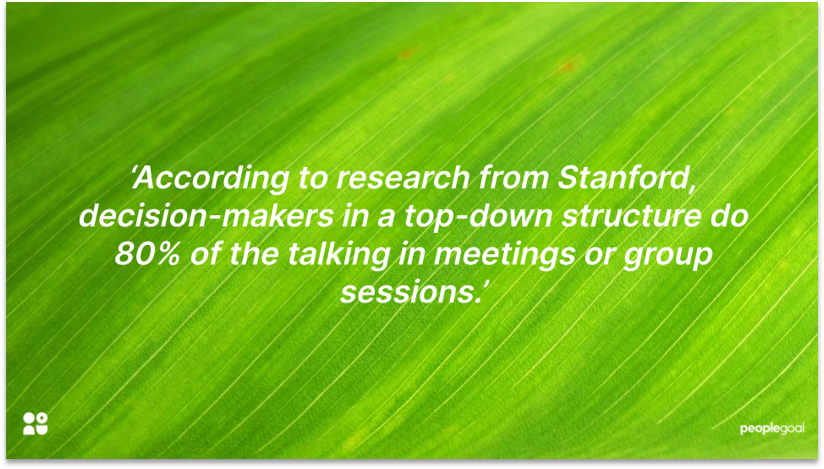
Less space for positive conflict
Rigid hierarchies can turn us all into yes-men! We nod along to ideas that we’d normally find implausible. This is especially true where companies don’t allow space for employees to critique the ideas of higher-ups.
This results in group-think. Group-think happens when a group values keeping the peace over accurate analysis and evaluation. Individuals unquestioningly follow-the-leader – to the detriment of finding a solution. Groupthink has been linked to the 2008 financial crisis and even flawed government responses to the coronavirus pandemic.
So how to avoid group-think? Don’t be afraid of positive conflict. Employees might be ideologically opposed on a subject, or one employee might have a different view point to the rest of the group. Don’t avoid discomfort in group discussions – complex projects are always going to involve competing view-points. Leaders should say, ‘This is productive, let’s keep discussing this until we reach a solution’.
On the employee side – ask questions. If your supervisor says they are taking a particular course of action, ask them why. This makes leaders accountable for decisions and more likely to avoid blind spots.
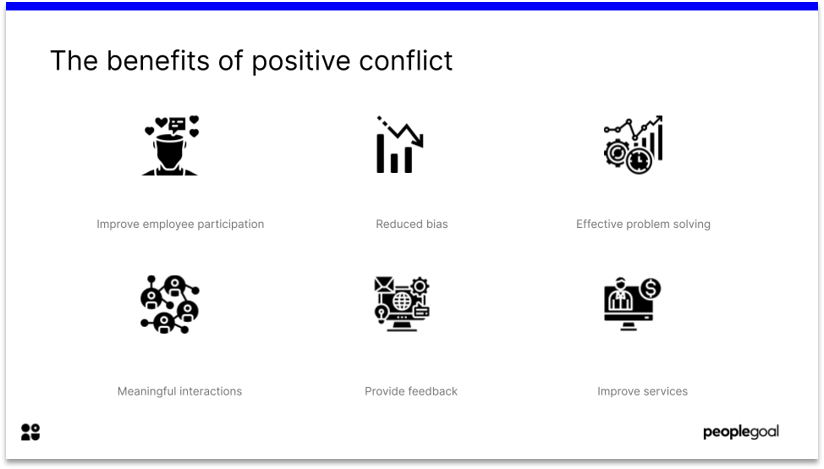
Expertise goes ignored
At a glance, hierarchal structures tell us – “this person is more skilled and experienced than this person”. The problem is, this isn’t always the case.
Sometimes a leader knows less about a subject than those in her/his team. But they are still entrusted with the power to make choices for the team as a whole. This is especially true in larger organisations where there are fewer contact points between supervisors and employees.
Further, leadership roles are often appointed for arbitrary reasons. You only have to look at the percentage of management roles held by women (29% in 2019) to see that bias can come into the equation. According to the Stanford study mentioned above, we judge someone is a leader for reasons as banal as the depth of their voice, facial features, height and attractiveness.
This leads us to overlook a lower-level employee’s capabilities. You may have secret experts lurking in the lower-levels of your company – find them and give them stretch roles.
Hierarchy cultures aren’t always a culture fit
Hierarchy cultures are becoming increasingly outmoded. Employees want more flexible cultures – the option to work-from-home, more compassionate environments when it comes to childcare, illness and work-life balance.
However, there are ways to adapt hierarchy cultures to the new world of work. Use more democratic communication styles, and create space for lower-level employees to voice their opinions. Decision-making can be decisive and collaborative at the same time.
To find out more about how culture impacts on every aspect of your business, why not read our article Create a Winning Work-From-Home Company Culture?
Development is crucial to a strong company culture PeopleGoal supports companies globally to build their employee development initiatives. To find out more, visit our App Store.
Ready to 3x Your Teams' Performance?
Use the best performance management software to align goals, track progress, and boost employee engagement.

